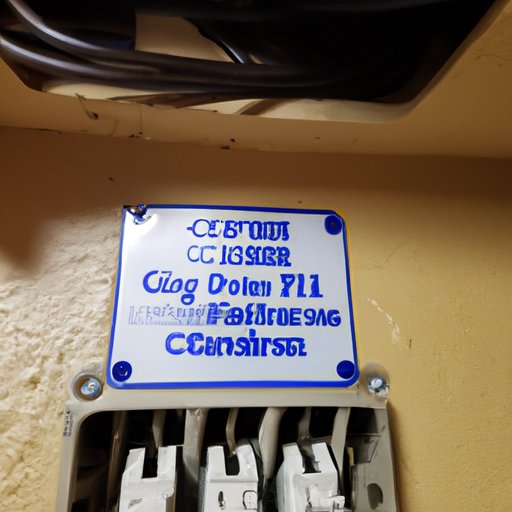Introduction
Ground fault circuit interrupter (GFCI) outlets are a type of outlet designed to protect people from electric shock. They’re commonly found in bathrooms, kitchens, and outdoor locations where water is present. In the event of a power surge or ground fault, GFCI outlets will trip and cut off the power supply. This can be a nuisance when it happens unexpectedly, but it’s an important safety feature that can save lives.

Exploring the Causes of GFCI Outlet Tripping
There are several possible causes of GFCI outlet tripping. The most common include faulty wiring, loose connections, overloaded circuits, and ground faults. Let’s take a closer look at each:
Faulty Wiring
Faulty wiring is one of the most common causes of GFCI outlet tripping. Faulty wiring can occur when wires are installed incorrectly or if they’ve become damaged over time. If you suspect there’s an issue with your wiring, it’s important to call a qualified electrician to inspect and repair any issues.
Loose Connections
Loose connections can cause GFCI outlets to trip. Over time, the electrical connections between the GFCI outlet and the wires may become loose or corroded. This can lead to a power surge or ground fault, which will cause the GFCI outlet to trip. To prevent this from happening, it’s important to regularly check the connections and tighten them if necessary.
Overloaded Circuits
Another common cause of GFCI outlet tripping is an overloaded circuit. When too many appliances or devices are plugged into an outlet, it can cause a power surge that will trip the GFCI outlet. To prevent this from happening, it’s important to spread out the load across multiple outlets and avoid plugging too many items into a single outlet.
Ground Faults
A ground fault is another common cause of GFCI outlet tripping. A ground fault occurs when electricity escapes from the intended path and finds an alternate route to the ground. This can happen if there’s a break in the wiring or if the wiring has become damaged over time. If you suspect a ground fault, it’s important to call a qualified electrician to inspect and repair any issues.

How to Reset and Troubleshoot GFCI Outlets
If your GFCI outlet trips unexpectedly, it’s important to reset it before attempting to troubleshoot the issue. To reset a GFCI outlet, simply press the “Reset” button located on the front of the outlet. If the outlet doesn’t reset, it’s important to unplug all appliances and devices from the outlet and check the wiring. If the wiring appears to be intact and free of damage, you can try resetting the outlet again. If the outlet still won’t reset, it’s best to call a qualified electrician to inspect and repair any issues.
When troubleshooting a GFCI outlet, it’s important to take safety precautions. Before inspecting or repairing the outlet, make sure to turn off the power supply at the circuit breaker. Also, wear rubber-soled shoes to reduce the risk of electric shock and never work on wet surfaces. Once you’ve ensured the area is safe, you can begin troubleshooting the issue.
Tips for Preventing GFCI Outlet Tripping
To prevent GFCI outlet tripping, it’s important to regularly check for loose connections and replace any faulty equipment. Additionally, it’s important to avoid overloading circuits by spreading the load across multiple outlets. Finally, if you’re installing a new GFCI outlet, make sure to hire a qualified electrician who understands the requirements and local codes.

Common Misconceptions About GFCI Outlets
Many people have misconceptions about GFCI outlets and their protective capabilities. It’s important to understand that GFCI outlets do not offer protection from electrical fire, power surges, or shocks. Although GFCI outlets are designed to detect and prevent ground faults, they are not designed to protect against other types of hazards.
GFCI Outlet Installation: What You Need to Know
Installing GFCI outlets can be a complex process, so it’s important to understand the requirements and local codes before beginning the project. In some areas, GFCI outlets must be installed by a qualified electrician. Make sure to research the requirements in your area before attempting to install a GFCI outlet yourself.
Electrical Safety: Why GFCI Outlets Are Necessary
GFCI outlets are essential for protecting people from electric shock. They can detect ground faults and quickly shut off the power supply to prevent injury. Additionally, GFCI outlets reduce the risk of electrical fires by cutting off the power supply when a surge or fault is detected.

Understanding the Benefits of GFCI Outlets
In addition to improved safety, GFCI outlets offer increased convenience. Many GFCI outlets are equipped with built-in surge protection and fault detection, so they can provide added peace of mind. Additionally, GFCI outlets can be easily reset with the push of a button, making them more convenient than traditional outlets.
Conclusion
GFCI outlets are an important safety feature designed to protect people from electric shock. While GFCI outlets can be inconvenient when they trip unexpectedly, it’s important to understand the causes and take steps to prevent tripping. Regularly check for loose connections, replace faulty equipment, and avoid overloading circuits. Additionally, make sure to hire a qualified electrician when installing GFCI outlets to ensure they’re installed correctly.
By understanding the causes of GFCI outlet tripping and taking the necessary precautions, you can help keep your family safe and minimize the risk of electric shock.
(Note: Is this article not meeting your expectations? Do you have knowledge or insights to share? Unlock new opportunities and expand your reach by joining our authors team. Click Registration to join us and share your expertise with our readers.)
